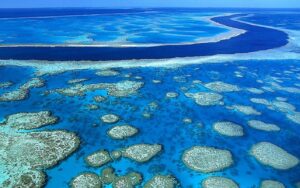
Uluru and neighboring Kata Tjuta are UNESCO World Heritage sites, and to Australia’s Aboriginal population, sacred ground. Over 100 million years in the making, sculpting by heavy winds, pouring rain and erosion have given the sandstone monoliths a sphinx-like effect. The rock’s softer layers show cave-like holes, while the more resistant rock deposit gives a rib-like effect.
Uluru and Kata Tjuta rise from the desert floor in Northern Australia. Uluru resembles a giant submarine, yet the bulk of the impressive sandstone castle in the sand remains hidden underground. Uluru is just the tip of a grand structure that begins far beneath the earth’s surface.
Uluru is mysterious and utterly irresistible. There is no way you won’t be moved by the miraculous boulder that looms in your path. Yet 16 miles from Uluru is the even more enormous and mesmerizing Kata Tjuta, which roughly translates to many heads.
The mammoth peaks of granite and mixed rock are a strong draw on their own. But they’re enhanced by British artist Bruce Munro’s immersive large-scale light installation “Field of Light.” In 1992, after traveling to Australia’s desolate desert center, the artist became fascinated by the land’s overwhelming power of light. “Uluru had a profound effect on me, and I wanted to create a very gentle installation on this fragile land,” said the artist Munro.
Munro’s masterwork blankets the desert floor with a solar-powered flower pageant. For maximum effect, see it at sunrise: As swaths of yellow, orange, blue and red palettes begin to appear, the Field of Light blossoms like perennials in springtime. Munro’s 50,000 carefully placed clusters of light stick out of the cultivated garden landing.
Another don’t-miss option in the southern desert is dining under the stars at Tali Wiru, which translates to beautiful dune. The open-air dining venue called Sounds of Silence offers sweeping vistas of both Uluru and Kata Tjut
Other ways to explore Uluru-Kata Tjuta National Park include a helicopter flight over the looming red landmarks and a camel ride along the dunes.
To keep the majority of tourists in one central location and to tread lightly on fragile grounds, in 1984 a tourist village called Ayers Rock Resort was created as the gateway to the sights of Uluru and Kata Tjuta.
To climb or not to climb?
In 1985, the guardianship of the land encompassing Uluru-Kata Tjuta National Park was handed back to its original Anangu Aboriginal owners. Immediately after the resolution, a greater responsibility to preserve the pristine land came into effect.
Many visitors are conflicted over whether to climb these sacred pinnacles. In Tjukurpa law that guides Anangu life, the rocks are sacramental grounds and must not be climbed. Climbing also breaks down the fragile sandstone rock bed. As a result, an official ban on climbing both Uluru and Kata Tjuta comes into effect in 2019.
Take a photo tour of Australia’s spectacular rock formations in the slideshow above.













